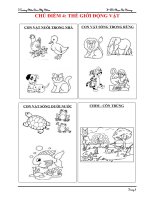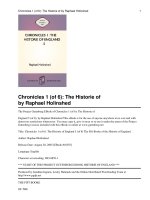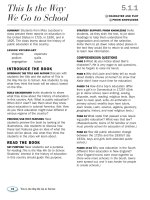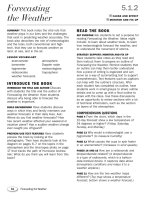5 1 1 the spelling bee TG
Bạn đang xem bản rút gọn của tài liệu. Xem và tải ngay bản đầy đủ của tài liệu tại đây (116.47 KB, 4 trang )
5.1.1
The Spelling Bee
SUMMARY
The story is about Kate, a fifth
grader with dyslexia. After being tested and
diagnosed, Kate had to give up going to camp
with her friends over the summer, and instead
worked on improving her reading. Her effort
paid off when she excelled at the school
spelling bee.
assignment
expanded
procedures
worshipped
INTRODUCE THE BOOK
INTRODUCE THE TITLE AND AUTHOR
Discuss
with students the title and the author of The
Spelling Bee. Based on the title, ask students
what kind of information they think this book
will provide. If students know what a spelling
bee is, ask them to share what they know.
Ask why the author might have given the book
this title.
BUILD BACKGROUND Ask students if they’ve
ever been frustrated or had a hard time with
something. How did they feel? How did they
handle this challenge? Did they come up with
a plan to make things better? How well did it
work? Discuss with students the meaning of
the word courageous. How might courage help
us when we face challenges?
PREVIEW/USE TEXT FEATURES
Invite students
to look at the pictures in the book. Ask: Who
is the main character? Have students look
on pages 12–13. Ask: What is the main
character doing? Why does she seem sad?
Have students look through to the end of
the book. Ask them how they think this story
will end.
12
READ THE BOOK
SET PURPOSE
Have students set a purpose
for reading The Spelling Bee. You may guide
students by suggesting that they think about
questions they have about the main character
or about the title itself.
STRATEGY SUPPORT: PRIOR KNOWLEDGE
LESSON VOCABULARY
acquainted
essential
guaranteed
reputation
CHARACTER AND PLOT
PRIOR KNOWLEDGE
As students read the book, encourage them
to connect the text to their own lives. For
example, after reading page 3, you may say:
“This reminds me of a time I got in trouble for
talking in class.” Making these connections
can help students better understand the
characters in a story and their motivations.
COMPREHENSION QUESTIONS
PAGES 3–7
What did you learn about Kate’s
character through her interactions with Mr.
Harper? (She’s a chatterbox; she has trouble
following rules; she wants to try hard; she’s
worked hard this year.)
PAGES 12–13
How did you feel when you read
about Kate having to stay home from camp?
(felt bad that Kate couldn’t be with her friends)
PAGE 16
Think about challenges in your own
life. How does this help you understand what
Kate was going through? (Possible response:
Students may suggest, that like Kate, they’ve
felt frustrated, nervous, excited.)
PAGE 19
What do you think the climax, or
high point, of the story is? The resolution, or
outcome? (Climax: When Kate is asked to spell
“pneumonia.” Resolution: After the first round
when Kate feels that she can do anything she
puts her mind to.)
To help reinforce comprehension,
invite students to retell the story in their
own words.
The Spelling Bee
16911_LRD_TG_012-013 12
12/28/05 12:47:35 PM
REVISIT THE BOOK
READER RESPONSE
1. He is strict but caring; contributed by
emphasizing that Kate can overcome her
reading difficulties if she didn’t become
distracted.
2. Know: Dyslexia is a disorder that causes
people to have difficulty reading; Want to
know: Possible response: Whether scientists
are working to find a cure for it.
3. Assign is a verb; assignment is a noun.
Assign means “to give as a share; allot,”
while assignment means “something
assigned.” Sentences will vary.
4. Possible responses: Kate will do well,
because of all her hard work. Or: Her
dyslexia may cause her to lose.
EXTEND UNDERSTANDING
Tell students that
when a story starts in the present and then
looks back to something that happened previously, it is called a flashback. Ask students
what happens on page 9. Ask students where
the flashback sequence ends. (Page 16)
What did students learn in the flashback that
helped them understand more about Kate and
her challenges?
RESPONSE OPTIONS
WRITING AND SPEAKING Use the vocabulary
words from the book and hold a class spelling
bee. Afterward, have students write how they
felt about the experience. Were they nervous
performing in front of the class?
WORD WORK
Look up the word essential in the
dictionary. What is its base? Have students
look at the definition of essence. (The qualities
of a thing that give it its identity; indispensable
properties.) Ask students to think about things
that are essential to them. Are these things
part of their essence, or identity? How?
Skill Work
TEACH/REVIEW VOCABULARY
Review the vocabulary words with students.
Have them write the words and underline
the base word in each word except essential.
Ask students how the meaning of the word
essential is similar to the concept of a base
word.
TARGET SKILL AND STRATEGY
CHARACTER AND PLOT
Remind students
that the plot is the pattern of events in
the story. As they read the story, have them
create story maps to track the events in the
story. Make sure students understand that
there is a shift in time, or flashback, that
begins on page 9.
PRIOR KNOWLEDGE Remind students
that prior knowledge is what they already
know about a topic. Tell students that when
they read a story, they can think about
how it connects to their lives to help them
understand more about the characters and
the plot. Have students brainstorm and
write down notes about challenges that they,
friends, or characters in other books have
faced. Invite students to share their findings.
ADDITIONAL SKILL INSTRUCTION
GRAPHIC SOURCES
Remind students that
graphic sources can include charts, maps,
drawings, posters, and diagrams. They can
be used to help their understanding of the
character and the plot. As students read,
have them create two character webs, one
for Kate and one for Mr. Harper.
SOCIAL STUDIES
CONNECTION
Watch a portion of the
documentary movie,
Spellbound, to learn more about the
national spelling bee and how contestants
prepare for the challenge.
The Spelling Bee
16911_LRD_TG_012-013 13
13
12/28/05 12:47:36 PM
Name
The Spelling Bee
Character and Plot
• The plot is an organized sequence of events.
• A character is a person who takes part in the events of a story.
1. Name some main characters in The Spelling Bee.
2. How does The Spelling Bee begin?
3. What is the problem in the story?
4. What do we learn in flashback?
5. What is the climax?
© Pearson Education 5
6. What is the resolution?
14
16911_LRD_TG_014-015 1
12/28/05 12:48:13 PM
The Spelling Bee
Name
Vocabulary
Directions In each of the following sentences, underline the synonym for the vocabulary word in ( ).
Note: Some synonyms may include more than one word.
Check the Words You Know
acquainted
essential
guaranteed
reputation
assignment
expanded
procedures
worshipped
1. Our teacher said it was necessary to bring our coats on the hike. (essential)
2. Paulo was friendly with all his neighbors. (acquainted)
3. Alice adored her new puppy. (worshipped)
4. “The project our teacher gave out yesterday was easy!” exclaimed Jasper. (assignment)
5. He had a good opinion of people about him. (reputation)
6. The two recipes showed different processes for making the same cookies. (procedures)
7. I made sure I had a chance for a good grade by studying hard. (guaranteed)
8. Reading that book stretched my horizons. (expanded)
Directions Select two vocabulary words and use each in a sentence below.
© Pearson Education 5
9.
10.
15
16911_LRD_TG_014-015 2
12/28/05 12:48:13 PM









